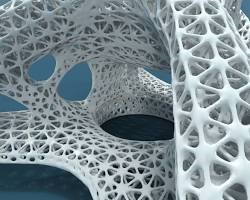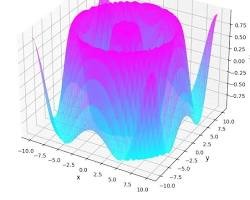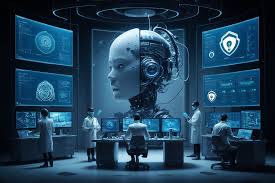
Artificial intelligence in architectural design: a creative partner or a competitor beyond imagination
In a rapidly changing world, artificial intelligence is taking the lead as a creative partner and assistant in providing unprecedented solutions. How? And what tools are driving this transformation? Let's explore.
Construct Vision Team
1/20/202516 min read

Introduction:
Architectural design is no longer just the imagination of an artist or the calculations of an engineer. It has become a canvas painted by architects armed with the capabilities of artificial intelligence, which surpasses their speed of thought by stages.
Artificial intelligence is no longer just modern techniques in architectural design that are merely assistive. It has become today a partner in creativity. There is no doubt that architects who adopt this technology will be at the forefront of the architectural future. This puts us in front of a challenge in a future without boundaries.
In a rapidly changing world, artificial intelligence takes center stage to be a creative partner and assistant in providing unprecedented solutions. How? And what are the tools that drive this transformation? Let's explore.
Artificial Intelligence and Architectural Design?
Artificial intelligence design (AI) is an advanced technology that uses algorithms and machine learning models to analyze data, generate ideas, and enhance creative and engineering processes.
Artificial intelligence contributes significantly to facilitating the design process, enhancing its efficiency, and finding innovative and sustainable solutions to complex architectural problems.
What is the role of artificial intelligence in architectural design?
Predictive Analysis and Idea Generation: Artificial intelligence can analyze market trends, climate, and user needs to provide accurate and effective design concepts. It uses tools such as Autodesk Generative Design to generate multiple design options based on specific criteria such as space, budget, or sustainability.
Intelligent Visualization: AI helps create realistic 3D models and simulation scenarios for design solutions using tools such as nTopology and Rhino AI. It also allows for visualizing the design before construction to identify potential problems.
Sustainable Architectural Design: It supports the design of buildings that rely on lower energy consumption using programs such as Sefaira to analyze energy consumption in buildings. It is used to develop environmentally friendly solutions in the design of smart cities and infrastructure.
Automation of Repetitive Processes: It eliminates the need for routine manual processes through tools such as Grasshopper and Dynamo, allowing architects to focus on innovation in architecture.
Performance Simulation and Analysis: It works to improve the performance of buildings by analyzing light, ventilation, and structural loads.
Advanced Creativity: Tools such as MidJourney and DALL-E enable architects to visualize unique architectural ideas in a non-traditional artistic style.
These tools and others save time through process automation and data analysis. They help reduce errors through accurate calculations and in-depth analysis. It also contributes to improving the environmental efficiency of buildings. And opens new doors for experimental and artistic design. This makes artificial intelligence in architectural design one of the most important future design tools, offering unlimited possibilities to transform ideas into innovative and practical designs that meet the needs of the present and future."
These techniques can lead to cost savings by reducing material consumption and simplifying manufacturing processes. They also provide a customization feature, allowing designs to be tailored to meet individual user needs.
One of the challenges facing generative design today is the complexity of algorithms, as it requires advanced skills in programming and mathematics. It also requires high computational power, which may be required for simulation and analysis processes. We cannot overlook the difficulty of evaluating thousands of generated designs, as it is a difficult and complex task. The cost of adopting generative design is high in some cases, especially for small and medium-sized companies.
The issue of intellectual property protection in generative design remains one of the important challenges in this field.
However, in architectural engineering, generative design enables us to design complex and lightweight structures. It also helps in studying the improvement of air flow and natural light inside buildings. And finding solutions for complex glass facades. For example, the Burj Khalifa project in Dubai used generative design algorithms to create the unique shape of the building. (Read more about the Burj Khalifa project in our article: Digital Design: The Future of Architecture Between Creativity and Technology).
Leading programs in the field of generative design:
There are many programs that support generative design techniques, each with its own characteristics and areas of specialization. Here are some of the most prominent programs:
nTopology System: This program is considered one of the first specialized programs in generative design, and it is characterized by high flexibility in creating complex models. It works exceptionally well with 3D printing and modern manufacturing technology. It provides integrated analysis tools that allow users to test their digital models before the manufacturing process. This enables easy customization of designs based on performance requirements.
Autodesk Generative Design: This is part of the Autodesk software suite. The program can create a wide range of design alternatives in a short time. It shows each design's strengths and weaknesses based on the requirements. It supports traditional manufacturing techniques such as casting, molding, and also additive manufacturing (3D printing). It integrates with other Autodesk programs such as Fusion 360 and Inventor. This tool will enable designers to overcome traditional design constraints. And enhance green manufacturing processes by reducing the use of materials and improving production efficiency.
ANSYS SpaceClaim: This is a 3D engineering design program that provides powerful and easy-to-use tools to enable engineers to create and edit engineering models quickly and efficiently. The program is part of the famous ANSYS product suite, which focuses on engineering simulation and finite element analysis. It relies on direct design technology, which allows users to easily modify 3D models. Its main features include reverse engineering (Reverse Engineering) and managing complex assemblies (Assemblies) and simplifying them to facilitate analysis and simulation. It is characterized by reducing design time by up to 40% thanks to rapid editing tools. It can also integrate with other ANSYS programs.
Altair Topology Optimization: This is an advanced engineering design technique that relies on optimizing shape and design based on structural and functional analysis. This technique is used to reduce the weight of materials and improve the mechanical and engineering performance of products, while maintaining structural integrity and achieving manufacturing efficiency. This technique is used by companies such as Airbus, Ford Motors, and NASA in their industries.
Grasshopper: This is part of the Rhino program, and it is used to create complex algorithms for generative design.
Real-life example: Autodesk Dreamcatcher tool
In one of the major projects, Autodesk Dreamcatcher was used to redesign the seats of San Francisco Airport. The team requested sustainable designs that reduce the use of materials and increase comfort. The team entered design criteria such as: bearing different weights. And using recyclable materials.
How did the tool help?
Artificial intelligence produced more than 1000 possible designs in hours, and engineers chose the design that was most compatible with the criteria. The result was a reduction in material consumption by 40% and a reduction in total costs.
Despite the challenges, generative design represents a qualitative leap in the field of engineering design. With the continued technological development and increasing awareness of the importance of this technique, it is expected that generative design will experience rapid growth in the coming years."
B. Improving Environmental Sustainability:
Artificial intelligence can be used to analyze the environmental impact of buildings, leveraging its immense capabilities in processing and analyzing large amounts of data, which represents a revolution in the field of construction and construction. This is done through several techniques:
- Life Cycle Assessment (LCA): Artificial intelligence can analyze the materials used in construction and assess their environmental impact throughout their life cycle, from extracting raw materials to disposing of them. Artificial intelligence can also estimate the amount of carbon emissions resulting from building and operating the building, which helps in choosing the most sustainable materials and designs.
- Improving Energy Efficiency: By analyzing climate data, energy usage, wind direction, and other factors that affect energy efficiency in the building. And then designing smart air conditioning systems that adapt to changing environmental conditions, which reduces energy consumption.
- Improving Lighting: Designing smart lighting systems that rely on natural light, which reduces the need for artificial lighting.
- Water Management: By analyzing water consumption patterns in the building and suggesting ways to reduce consumption. And designing smart irrigation systems for landscapes, which reduces water waste.
- Choosing the Optimal Site: By analyzing geological and environmental data to determine the sites that are less prone to natural hazards such as earthquakes and floods. And evaluating the environmental impact of the proposed site, such as its impact on wildlife and local ecosystems.
- Improving Indoor Air Quality: Artificial intelligence can analyze indoor air quality and identify sources of pollution. And designing effective ventilation systems that improve indoor air quality.
Analyzing the environmental impact of buildings helps in designing buildings that consume less energy and produce fewer carbon emissions. It can also lead to cost savings in the long term by reducing operating and maintenance costs. It also contributes to creating a healthy and safe indoor environment for users. It helps in adapting to climate change and reducing environmental impact.
Examples of programs for analyzing the environmental impact of buildings:
- LCA Programs: These programs calculate the environmental impact of a building throughout its entire life cycle, from extracting raw materials to disposing of them. Examples of these programs: SimaPro, Gabi, and Umberto. With the increasing demand for sustainable buildings, these tools will become a basic standard in the construction industry.
- Energy Simulation Programs: These programs simulate the building's performance in terms of energy consumption, and help in determining the measures needed to improve efficiency. Examples of these programs: EnergyPlus, TRNSYS, and IESVE.
- Sustainability Assessment Programs: These programs use sustainability assessment standards such as LEED or BREEAM to evaluate the building's performance in terms of sustainability. Examples of these programs: LEED Online, BREEAM Assessment.
- Indoor Air Quality Analysis Programs: These programs analyze indoor air quality and identify sources of pollution. Such as Sefaira.
Real-life example: The Sefaira tool
In a project to build a school in New York, Sefaira was used to analyze the building design in terms of: energy consumption efficiency. Natural ventilation. And daylighting.
How did the tool help?
The analysis showed that adding longer windows increases natural light by 30%. The tool suggested simple changes such as changing the building's angle by 15 degrees to improve air flow. The result was a 20% saving in electricity costs and a reduction in carbon emissions."
C. 3D Visualization and Data Analysis:
The field of 3D visualization and data analysis is witnessing remarkable development thanks to the rapid advances in artificial intelligence. Artificial intelligence plays a pivotal role in improving the efficiency and accuracy of these processes, and opening up new horizons for applications in various fields.
Creating 3D Models: By automatically generating 3D models from 2D images or even from textual descriptions. And improving the quality of existing 3D models using machine learning techniques, such as noise removal, gap filling, and improving details.
Analyzing Images and 3D Data: By recognizing different shapes and objects in images and 3D data with high accuracy. And measuring dimensions, sizes, volumes, and areas in 3D models with high accuracy. Artificial intelligence can also discover patterns and relationships between 3D data, which helps in better understanding natural and engineering phenomena.
Applications in Various Fields:
- Medicine: Artificial intelligence can be used to analyze CT and MRI images to create 3D models of internal organs, which helps in diagnosis and surgical planning.
- Engineering: Artificial intelligence can be used to analyze building and engineering structure models to identify weak points and improve design.
- Manufacturing: Artificial intelligence can be used to control industrial robots to perform manufacturing tasks with high precision, based on 3D data.
- Virtual Reality and Augmented Reality: Artificial intelligence can be used to create more realistic and interactive virtual reality and augmented reality experiences.
Examples of artificial intelligence applications in 3D visualization and data analysis:
- 3D Printing: Artificial intelligence can improve the 3D printing process by analyzing designs and improving them, and determining the best parameters for printing.
- Surgical Robots: Artificial intelligence can guide surgical robots with high precision during surgical procedures, based on 3D data of the patient.
- Developing Self-Driving Cars: Artificial intelligence can analyze 3D data from various sensors of the car, such as lidar and radar, to enable the car to understand its environment and make appropriate decisions.
It is expected that this field will witness greater developments in the coming years, which will contribute to improving our daily lives.
Examples of specialized programs in 3D visualization and analysis:
- CloudCompare: A powerful open-source program for analyzing 3D models, with a particular focus on point clouds (Point Clouds) resulting from laser scanning (LiDAR) or photogrammetric techniques. It supports a wide range of file formats and offers powerful tools for measuring distances, volumes, and comparing models.
The program was first developed in 2004 as a tool for comparing point clouds, but it evolved to become a comprehensive platform for analyzing 3D data.
- MeshLab: Another open-source program for editing and processing 3D models. It provides a wide range of filters and tools to improve the quality of models. It is widely used for processing and analyzing point clouds and 3D models. It is popular in engineering, artistic, and academic fields, and is considered a powerful tool for applications such as reverse engineering, engineering analysis, and digital restoration. Easy to use. Free. And versatile in editing and processing 3D models. It lacks some advanced tools found in commercial programs such as AutoDesk or ANSYS. And it may require technical expertise to improve results.
- Agisoft Metashape: A powerful commercial program for creating high-precision 3D models from digital images. It uses photogrammetric and artificial intelligence techniques to achieve accurate and fast results. The program allows the creation of accurate 3D models from images taken from multiple angles, which makes it an effective tool in many industries.
It is used to create accurate terrain maps using aerial images. In cloud computing for points to create a dense set of points that represent the surface of the object or the photographed area. And it integrates with GIS technologies: .And with drones (Drones).
- Reality Capture: An advanced program specialized in creating high-precision 3D models and digital maps using photogrammetric technology. It relies on images taken with ordinary cameras or drones, and point cloud data (Point Cloud) taken from laser scanning devices.
Data Analysis Programs with 3D Visualization Capabilities:
- MATLAB: A powerful development environment for dealing with data and graphics. It provides a wide range of tools and functions for creating and visualizing 3D data.
- Python: A flexible and powerful programming language. It is used with libraries such as NumPy, SciPy, and Matplotlib to process and analyze data and create 3D graphics."


R: An open-source programming language and environment for statistical computing and graphics, providing a wide range of packages for creating and visualizing 3D data.
Cloud Platforms for Artificial Intelligence and Machine Learning:
Google Colaboratory: A free machine learning platform that allows running Python code in the browser, and provides free access to graphics processing units (GPUs) to accelerate calculations. It offers the ability to use GPU and TPU. Its features include machine learning, data analysis, and cloud models without the need for local resources.
Amazon SageMaker: A comprehensive cloud platform for machine learning from AWS (Amazon Web Services), providing a wide range of tools and frameworks to help developers build and deploy machine learning models at scale, and analyze big data.
MidJourney: An artificial intelligence platform specialized in generating artistic and aesthetic images based on textual descriptions. It represents one of the most prominent artificial intelligence models in the creative and artistic field, but it focuses more on artistic and creative aspects. It helps in producing artistic visualizations for architectural and engineering projects. And creating imaginary scenes for spaces or buildings based on a precise description.
DALL-E: An artificial intelligence model developed by Open-ai, specialized in creating images based on text. And creating paintings and artistic drawings. And visualizing abstract concepts in a visual way.
Example: The Twinmotion Tool
Some design companies in Dubai use Twinmotion to display their designs.
How did the tool help?
It transforms drawings into an interactive 3D model that the client can "walk through" using a virtual reality headset. This allowed for immediate modification based on the client's feedback, such as changing colors and adding new features. The result was saving time that was wasted in preparing manual models to increase client satisfaction.
D. Automating Architectural Design:
Accelerating the design process from weeks to hours using programs such as Rhino and Grasshopper.
Example: The Spacemaker AI Tool
When an architectural firm in Oslo decided to build a new residential neighborhood, it used Spacemaker AI to analyze: Building distribution to ensure ventilation and natural lighting. Green spaces that reduce temperatures.
How did the tool help?
The tool analyzed 10 million building distribution possibilities in one day. Then, it presented an ideal proposal that ensures 20% more natural light and increased green spaces. The result was a reduction in surrounding temperatures by 3 degrees Celsius and increased resident satisfaction.
Challenges in Applying Artificial Intelligence in Design:
Lack of Technical Knowledge and Skills: Most architects today do not have a strong background in programming or dealing with advanced tools such as machine learning and generative design. This hinders their ability to fully exploit the potential of artificial intelligence. For example, architects who are not proficient in using tools such as Grasshopper or Autodesk Generative Design may lose the advantage of presenting innovative design options quickly.
High Cost of Advanced Technologies: Some artificial intelligence tools are very expensive and require large investments in software, hardware, and infrastructure. Using programs such as ANSYS or advanced workstations to simulate structural performance may not be available to architects or small companies.
Ethical Challenges: Artificial intelligence tools rely heavily on data. Misuse of data may lead to privacy violations or socially unfair designs.
Artistic and Legal Sensitivities: Questions about the intellectual property of designs generated by artificial intelligence.
Resistance to Change: Some professionals in the field may be reluctant to adopt technology due to fear of being replaced by machines or due to traditional ways of working. In projects to restore heritage buildings, some rely on manual methods and see that artificial intelligence tools may lead to a loss of artistic touch.
Integration with Traditional Processes: Integrating artificial intelligence with traditional design and construction stages can be difficult, especially when there is no compatibility between artificial intelligence tools and current project management systems. A project that uses artificial intelligence to design complex facades, for example, may face challenges in translating these designs into traditional structural plans.
Quality of Input Data: Artificial intelligence systems rely on high-quality data. Any deficiency or error in the data may lead to ineffective designs. For example, if the climate data used in designing a building relies on old forecasts, this may lead to an unsustainable design.
Despite these challenges, the ability to overcome them will open up new horizons for architects. Investing in training, developing clear ethical policies, and improving technological infrastructure will make artificial intelligence an indispensable tool in designing the future."


Architectural Projects Using Artificial Intelligence:
The "World Trade Center 2" Project:
In designing the new tower for the "World Trade Center 2" project in New York, artificial intelligence tools were used to generate innovative design ideas that take into account natural lighting, wind, and energy performance. Here, there was a need to integrate the outputs of artificial intelligence with the traditional vision of the architect and the high safety standards of the building.
The project demonstrated the importance of combining artificial intelligence with human creativity to reach practical and innovative solutions. It was one of the prominent examples of integrating artificial intelligence with human creativity in complex architectural designs.
During the development of the design, the project faced several challenges related to sustainability, environmental performance, and achieving a distinctive architectural vision while adhering to strict safety standards. Here is an explanation of how some of the challenges were addressed:
In terms of sustainability and environmental performance analysis:
Designing a building that significantly reduces energy consumption and utilizes natural resources such as natural lighting and ventilation. Simulating the different climatic effects on the building's thermal performance.
Artificial intelligence tools such as Autodesk Generative Design and Ladybug Tools were used to analyze climate data and solar radiation accurately. Artificial intelligence helped in determining the optimal design for glass facades to provide maximum natural lighting without increasing the thermal load inside the building. Smart natural ventilation systems that rely on wind direction and temperature were added.
Achieving a distinctive architectural vision with structural efficiency:
The challenge was to design an impressive and visually complex facade without compromising structural efficiency or increasing costs.
ANSYS Space Claim was used to develop innovative geometric shapes that achieve structural efficiency. Artificial intelligence helped in testing hundreds of different facade designs to determine the shape that combines beauty and efficiency.
Compliance with high safety standards:
The project is located in a historically and security-sensitive site that requires adherence to the highest safety standards.
The team relied on artificial intelligence to design safety systems, including evacuation plans and simulating emergency scenarios. Tools such as Pathfinder were used to simulate crowd movement in evacuation situations, which led to improving the design of stairs and exits to ensure rapid evacuation.
Integration between digital technologies and traditional construction:
An innovative design that relies on artificial intelligence tools but must be converted into a practical construction using traditional techniques.
Advanced modeling programs such as BIM (Building Information Modeling) were used to ensure that digital designs can be implemented effectively. There was close cooperation between digital design teams and contractors to ensure the conversion of ideas into practical outputs.
Integrating modern technology without compromising cultural identity:
Achieving a design that reflects the spirit of New York, while integrating advanced technology.
Artificial intelligence helped in studying the architectural patterns of New York and analyzing what makes it unique. Modern design elements inspired by the city's traditions were included, such as the innovative use of glass and steel.
The World Trade Center 2 project demonstrated that major design challenges can be solved when combining modern technology such as artificial intelligence with human creativity. The key is collaboration between experts from different disciplines to achieve an integrated vision.
The future of artificial intelligence in architecture and smart buildings:
85% of major architectural firms plan to apply artificial intelligence in their projects by 2030.
Designs using Generative Design will reduce waste by 20%.
It is also expected that artificial intelligence-based robots will become an integral part of the construction process.
In addition to more open-source tools in the near future, which promises to provide tools available to everyone at affordable prices, and makes artificial intelligence one of the future tools of architecture.
Conclusion:
Artificial intelligence in architectural design is the new partner that will continuously open up new horizons towards a competition of a creative kind: from saving time and costs to presenting designs that exceed the limits of imagination.
We are today facing a wide and full-of-surprises future. Are you ready to discover this new world and embark on it?
Can you imagine how your projects will look with these tools? Share your vision."




Share the post
Subscribe to our newsletters:


The Potential of Artificial Intelligence in Smart Architecture
A. Generative Design:
Generative design is a revolution in the world of engineering creativity. It is a modern technique that relies on algorithms and digital calculations to generate a wide range of innovative design solutions. Instead of manually designing a single product, generative design allows for the exploration of thousands of design options in a short time, opening up new horizons for creativity and innovation.
Initially, setting the criteria: The designer begins by setting a set of criteria and constraints that the final design must meet. These criteria may include: performance such as strength, weight, flexibility, and the type of materials used and their cost. Available manufacturing techniques. In addition to the general shape and aesthetic details.
A computer algorithm that reflects these criteria and constraints is developed. The algorithm creates 3D models of potential designs based on these criteria. Then, the designs that are generated automatically are evaluated based on the specified criteria. These designs are classified and the best solutions that achieve the optimal balance between all criteria are identified.
The designer can modify the criteria and algorithm to improve the results. Human input can also be integrated into this process to add a personal touch to the final design.
Generative design can be used to create complex and energy-efficient architectural structures. It can also be used to design everyday products such as chairs, furniture, and shoes. And complex spare parts using additive manufacturing techniques such as 3D printing."




